Hyundai Bayon vs Mazda CX-30 – Which car suits you better?
Two cars, one duel: Hyundai Bayon meets Mazda CX-30.
Which one wins in performance, efficiency and value for money? Find out now!
Costs and Efficiency:
Looking at overall running costs, both models reveal some interesting differences in everyday economy.
Hyundai Bayon has a clearly perceptible advantage in terms of price – it starts at 20100 £, while the Mazda CX-30 costs 25200 £. That’s a price difference of around 5177 £.
Fuel consumption also shows a difference: Hyundai Bayon manages with 5.40 L and is therefore barely noticeable more efficient than the Mazda CX-30 with 5.70 L. The difference is about 0.30 L per 100 km.
Engine and Performance:
Power, torque and acceleration are the classic benchmarks for car enthusiasts – and here, some clear differences start to show.
When it comes to engine power, the Mazda CX-30 has a significantly edge – offering 186 HP compared to 100 HP. That’s roughly 86 HP more horsepower.
In acceleration from 0 to 100 km/h, the Mazda CX-30 is distinct quicker – completing the sprint in 8.30 s, while the Hyundai Bayon takes 11.30 s. That’s about 3 s faster.
In terms of top speed, the Mazda CX-30 performs somewhat better – reaching 204 km/h, while the Hyundai Bayon tops out at 179 km/h. The difference is around 25 km/h.
There’s also a difference in torque: Mazda CX-30 pulls to a small extent stronger with 240 Nm compared to 200 Nm. That’s about 40 Nm difference.
Space and Everyday Use:
Cabin size, boot volume and payload all play a role in everyday practicality. Here, comfort and flexibility make the difference.
Both vehicles offer seating for 5 people.
In curb weight, Hyundai Bayon is noticeable lighter – 1170 kg compared to 1455 kg. The difference is around 285 kg.
In terms of boot space, the Mazda CX-30 offers slight more room – 430 L compared to 411 L. That’s a difference of about 19 L.
In maximum load capacity, the Mazda CX-30 performs a bit better – up to 1406 L, which is about 201 L more than the Hyundai Bayon.
When it comes to payload, Mazda CX-30 slight takes the win – 496 kg compared to 465 kg. That’s a difference of about 31 kg.
Who comes out on top?
Overall, the Mazda CX-30 shows itself to be dominates this comparison and secures the title of DriveDuel Champion.
It convinces with the more balanced overall package and proves to be the more versatile choice for everyday use.
 @ Mazda Motor Corporation
@ Mazda Motor Corporation
Mazda CX-30
Hyundai Bayon
The Hyundai Bayon slips neatly between city runabout and small SUV, offering surprising practicality and a fresh, confident design that stands out in urban traffic. It's an easy buy for shoppers who want smart packaging, tidy handling and a dash of personality without fuss — a sensible little crossover that makes everyday driving a bit more enjoyable.
details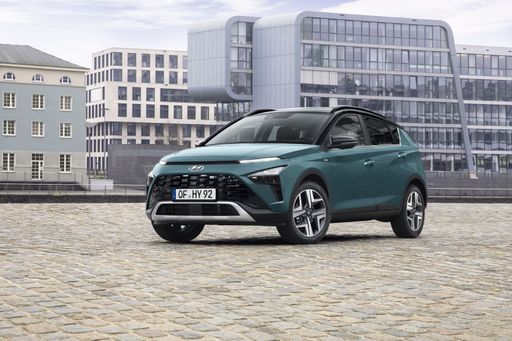 @ Hyundai Motor Company
@ Hyundai Motor Company
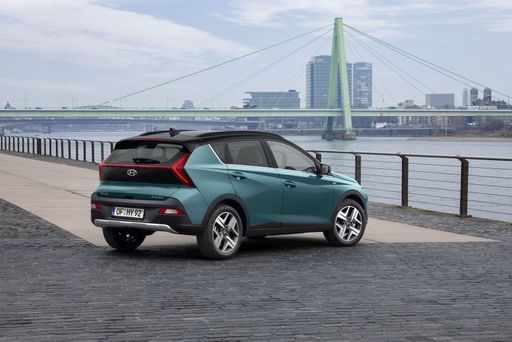 @ Hyundai Motor Company
@ Hyundai Motor Company
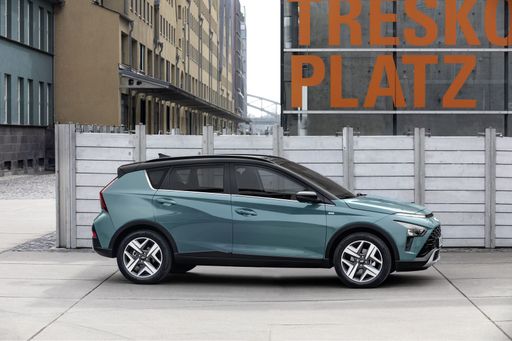 @ Hyundai Motor Company
@ Hyundai Motor Company
 @ Hyundai Motor Company
@ Hyundai Motor Company
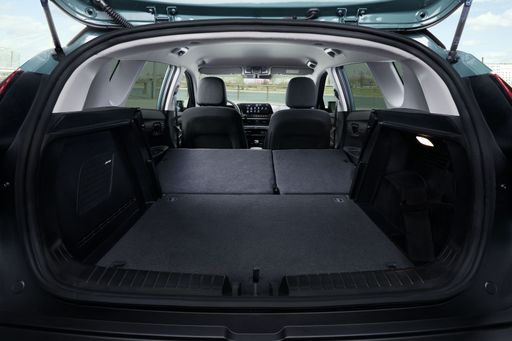 @ Hyundai Motor Company
@ Hyundai Motor Company
Mazda CX-30
The Mazda CX-30 blends sleek coupe-like lines with the practicality of a compact crossover, feeling more premium than its price tag suggests. It’s a joy to drive for anyone who likes a taut chassis and an interior that treats daily commutes like a small luxury escape.
details @ Mazda Motor Corporation
@ Mazda Motor Corporation
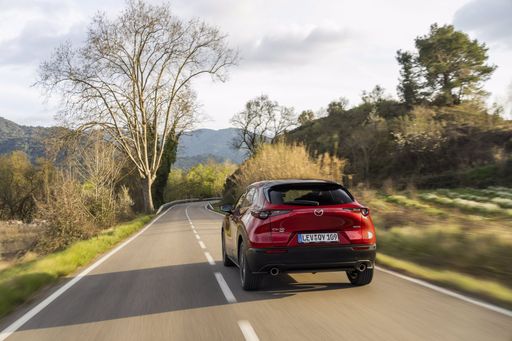 @ Mazda Motor Corporation
@ Mazda Motor Corporation
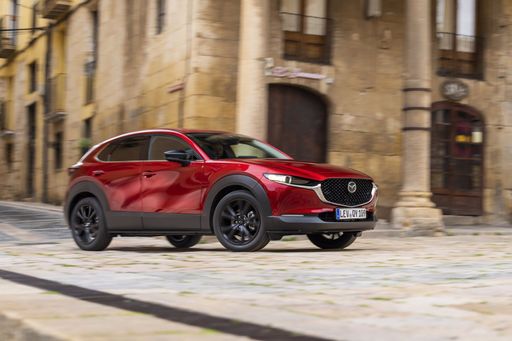 @ Mazda Motor Corporation
@ Mazda Motor Corporation
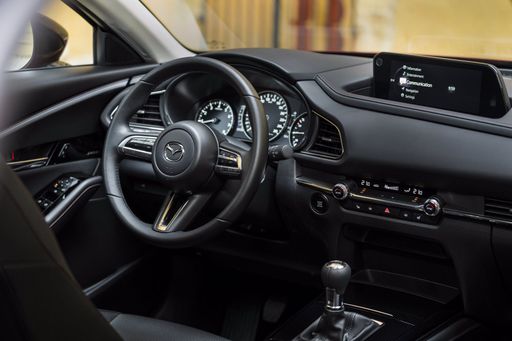 @ Mazda Motor Corporation
@ Mazda Motor Corporation
 @ Hyundai Motor Company
@ Hyundai Motor Company
|
 @ Mazda Motor Corporation
@ Mazda Motor Corporation
|
|
|
|
Costs and Consumption |
|
|---|---|
|
Price
20100 - 25800 £
|
Price
25200 - 36800 £
|
|
Consumption L/100km
5.4 - 5.5 L
|
Consumption L/100km
5.7 - 6.6 L
|
|
Consumption kWh/100km
-
|
Consumption kWh/100km
-
|
|
Electric Range
-
|
Electric Range
-
|
|
Battery Capacity
-
|
Battery Capacity
-
|
|
co2
124 g/km
|
co2
129 - 148 g/km
|
|
Fuel tank capacity
40 L
|
Fuel tank capacity
48 - 51 L
|
Dimensions and Body |
|
|---|---|
|
Body Type
SUV
|
Body Type
SUV
|
|
Seats
5
|
Seats
5
|
|
Doors
5
|
Doors
5
|
|
Curb weight
1170 - 1195 kg
|
Curb weight
1455 - 1587 kg
|
|
Trunk capacity
411 L
|
Trunk capacity
422 - 430 L
|
|
Length
4180 mm
|
Length
4395 mm
|
|
Width
1775 mm
|
Width
1795 mm
|
|
Height
1500 mm
|
Height
1540 mm
|
|
Max trunk capacity
1205 L
|
Max trunk capacity
1398 - 1406 L
|
|
Payload
460 - 465 kg
|
Payload
458 - 496 kg
|
Engine and Performance |
|
|---|---|
|
Engine Type
Petrol
|
Engine Type
Petrol MHEV
|
|
Transmission
Manuel, Automatic
|
Transmission
Manuel, Automatic
|
|
Transmission Detail
Manual Gearbox, Dual-Clutch Automatic
|
Transmission Detail
Manual Gearbox, Automatic Gearbox
|
|
Drive Type
Front-Wheel Drive
|
Drive Type
Front-Wheel Drive, All-Wheel Drive
|
|
Power HP
100 HP
|
Power HP
140 - 186 HP
|
|
Acceleration 0-100km/h
11.3 - 12.4 s
|
Acceleration 0-100km/h
8.3 - 10.3 s
|
|
Max Speed
176 - 179 km/h
|
Max Speed
191 - 204 km/h
|
|
Torque
172 - 200 Nm
|
Torque
238 - 240 Nm
|
|
Number of Cylinders
3
|
Number of Cylinders
4
|
|
Power kW
74 kW
|
Power kW
103 - 137 kW
|
|
Engine capacity
998 cm3
|
Engine capacity
1998 - 2488 cm3
|
General |
|
|---|---|
|
Model Year
2024
|
Model Year
2025
|
|
CO2 Efficiency Class
D
|
CO2 Efficiency Class
D, E
|
|
Brand
Hyundai
|
Brand
Mazda
|
What drivetrain options does the Hyundai Bayon have?
The Hyundai Bayon is available as Front-Wheel Drive.
The prices and data displayed are estimates based on German list prices and may vary by country. This information is not legally binding.
